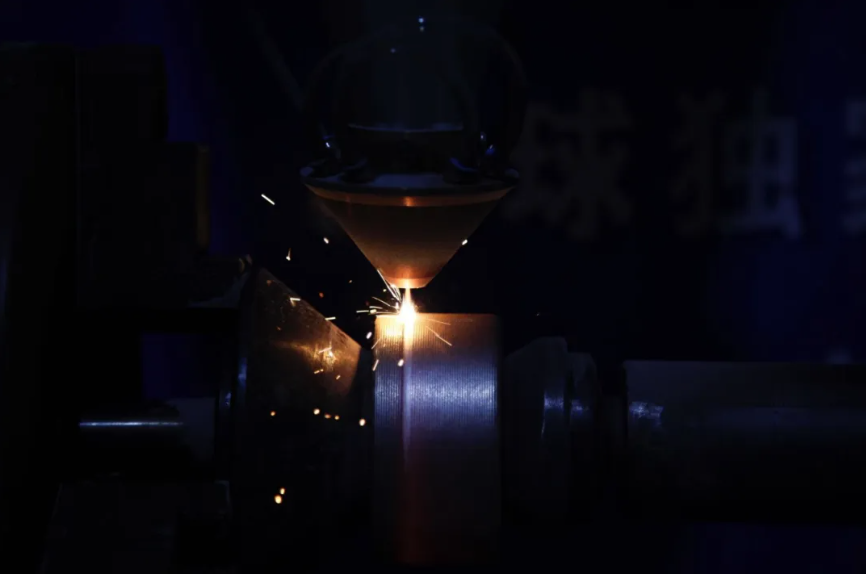Carbon fiber fuselage with 8m seams can be CO2 laser welded
European researchers say they have successfully welded two halves of an 8-meter-long fuselage made of carbon-reinforced fibers with a CO2 laser. This means that ultralight passenger aircraft can be manufactured using this method.
The demonstration, completed by a large international consortium led by Airbus and comprising several Fraunhofer institutes, provides proof of concept for the chipless connection of carbon fiber-reinforced thermoplastic (CFRTP) component structures with a CO2 laser.
Dynamic Beam Shaping
Working under the Multifunctional Fuselage Demonstrator (MFFD) project, which is part of the EU's wider Clean Skies 2 research program, the team at the Fraunhofer Institute for Materials and Beam Technology (IWS) in Dresden says the novel construction method and process will significantly reduce weight, material and time. The novel construction method and process will significantly reduce weight, material, and time.
They used a CO2 source to weld long seams on a large-volume thermoplastic aircraft fiber composite structure on the outside of the autoclave, which is considered a world-first achievement.
“On the left side of the MFFD, the process method developed by Fraunhofer IWS produces the final longitudinal seam joint between the upper and lower half of the aircraft fuselage section, which is made of carbon fiber-reinforced thermoplastic, made of carbon fiber-reinforced thermoplastic,” Group Manager Maurice Langer and his colleagues report.
“The so-called CONTIjoin process is a combination of CO2 laser technology and highly dynamic beam shaping, where the laser power is controlled in real-time to keep the temperature in the joining zone constant. At the same time, it automatically adjusts the beam shape in the weld gap.
Laser wavelength crucial
The Dresden team, which will report its findings next week at the International Air and Space Fair (ILA 2024) in Berlin, also says that the 10.6 μm CO2 laser wavelength plays a crucial role thanks to much higher light absorption than the 1 μm emitting fiber lasers that are now widely used for industrial welding.
The use of lasers means that there is no need to mechanically join components and double materials using classic riveted overlapping joints, so the hull shells made of thermoplastic composites are significantly lighter than conventional sections.
The IWS team noted, “This marks an important step in the manufacture of aircraft using new thermoplastic high-performance materials, as it enables the production of high-strength and weldable large components.
“Conventional manufacturing processes for these materials are often energy-intensive and expensive,” Langer added. “Therefore, together with our project partner Airbus, we have developed a process that allows us to join components on the outside of the autoclave using stepped-axis technology while achieving excellent strength properties for this composite material.
“New material categories require innovative production methods. the MFFD's declared goal is to reduce the weight of the airframe by up to one ton.
The significant weight reduction will significantly reduce overall energy demand, fuel consumption and associated emissions throughout the life of the aircraft.
“With the CONTIjoin process developed by Fraunhofer IWS, we have succeeded in taking an important economic and ecological step forward for future aircraft development and related applications,” said Langer.
Overlapping joints
One of the key elements of the project is the gradual joining of the upper and lower shells of an aircraft fuselage by placing several laminating strips in succession on top of each other and automatically positioning them in a stepped geometry on the surface of the half-shell.
“The resulting overlapping joint restores the initially interrupted force flow of the fiber composite between the half-shells and creates a reliable load-transfer joint,” explains the IWS team.
The higher absorption of CO2 sources also means that the energy required at the interface between the individual components can be minimized, which is said to eliminate the subsequent processing steps that would normally be required.
Another key development is said to be the IWS team's “ESL2-100 module”, which was developed in-house at the Dresden facility.
Peter Rauscher, manager of the High-Speed Laser Processing department at IWS, says that this makes it possible to interpret the various sensor signals to implement the appropriate control algorithms.
“This offers the possibility of monitoring and adaptively controlling the welding process in real time, which is impossible with conventional control electronics,” says Rauscher. “For example, in addition to controlling the welding temperature along the weld gap, we can take into account the position, width, and curvature of the aircraft half shell.”
Future plans will increase the method's technology readiness level (TRL) for qualification in the aerospace industry and beyond.
“The CONTIjoin technology developed is attractive to aircraft manufacturing and other industries,” notes Lange. “In addition to the aviation industry, the solution can also be used in shipbuilding, truck and trailer manufacturing, as well as in rail transportation or the further development of modern wind turbines.”



Comments
Post a Comment